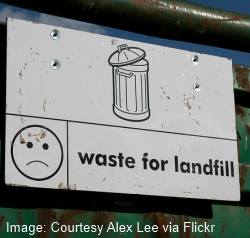EU Roadmap Will Ensure That Waste is Managed as a Resource By 2020
No. This is not the usual sort of crystal ball gazing article you usually see at the start of the year. This is real!
There is a lot that goes on within EU government administration that will have a big impact on the lives of the average person in years to come, but gets very little publicity in the United Kingdom, and I doubt it gets a much better airing elsewhere either. So, I am indebted to Paul Sheridan and Olivia Quaid, of CMS Cameron McKenna LLP, who have highlighted this to me, via their article within the CIWM's Wastes Management Journal (September 2011). That in turn has enabled me to publicise here, the launch last summer of the EU publication titled “A Roadmap to a Resource Efficient Europe”.

It is not just because the numbers for resource usage and waste produced are huge, as given by the Commission the EU:
– Disposes of 2.7bn tonnes of waste annually
– 98m tonnes of which is hazardous.
– Only 40 percent of the EU's solid waste is re-used or recycled.
It is because there will within the next few years be another new layer of regulations to ensure that:
1. Higher priority is given to re-use and recycling.
2. All product design integrating a life-cycle approach, is implemented
3. Yet bigger incentives for waste prevention and recycling, and
4. More public investment takes place in modern facilities for waste treatment and recycling.
This “plan” came about, on 20 September 2011 when the European Commission launched several publications – all with relevance to resource efficiency and the sustainable use of natural resources throughout the EU. The master document is (as above) “A Roadmap to a Resource Efficient Europe (COM(2011) 571/3) (The Resource Efficiency Roadmap)”. This builds on existing strategies form environmental sustainability such as the roadmap to a low carbon society.
Now, although it might be assumed that these publications would be litte more than a “talking shop”, we understand that some of the proposals will become law or policy, and if either happen, they will certainly have large direct and indirect impacts. There will be many new regulations for the waste management industry, the public sector and for private businesses.
There is also plenty of optimism here that this will bring many new opportunities and developments for the “waste” (soon to be “resource” industry). So you need to know of this, and how it will be done.
The so called “Resource Efficiency Roadmap” identifies the areas that the EU bureacrats will concentrating on in order to transform the approach that all member nations adopt towards the use of resources and their cost and value, across a range of governmment instruments.
It will move towards achieving a number of what it calls “milestones” (isn't it more usual to call such things targets?). And, also gives hints on the devices intended to secure achievement of each “milestone”.
The methods include;
– legislation,
– market-based instruments,
– refocusing of funding instruments and,
– the promotion of sustainable production and consumption.
So What Will Interest the Waste management Community Most?
The document seeks; “the establishment of targets and indicators providing predictability and transparency in resource efficiency by 2013.
This is to be done through; “a participative process involving policy makers, NGOs, business and consumers”. In this process; “a greater role is envisaged for eco-design, eco-labelling and greener spending by public bodies”.
Significant emphasis is placed on energy efficiency in the public sector (and also those private companies engaged by governments in working for the public sector).
Waste Will be Managed as a Resource by 2020
So, Waste will cease to exist! That's official! The Milestone document says:
“By 2020, waste is managed as a resource. Waste generated per capita is in absolute decline. Recycling and re-use of waste are economically attractive options for public and private sectors due to widespread separate collection and the development of functional markets for secondary raw materials. More materials, including materials having a significant impact on the environment and critical raw materials, are recycled. Waste legislation is fully implemented… Energy recovery is limited to non-recyclable materials, landfilling is virtually eliminated and high quality recycling is ensured.”
How Will This be Achieved?
“The Commission aims to stimulate the secondary materials market and demand for recycled materials through economic incentives and developing end-of-waste criteria; review existing targets, with residual waste close to zero (in 2014); assess the introduction of minimum recycled material rates, durability and reusability criteria and extensions of producer responsibility for key products (in 2012); assess where legislation could be aligned to improve coherence (in 2013/2014); facilitate the exchange of best practice on collection and treatment of waste among member states and develop measures to combat more effectively breaches of EU waste rules (in 2013/2014).”
So, welcome to 2012! It is to be a brave new regulatory world, and expect big news and developments in the EU for “wasters” in the coming years.
The Waste Technology Industry is about to grow further! Waste technology is big news – so look out for our coming money off offer on the new edition of our publication “An Introduction to Waste Technologies – 2012”. It will be an exclusive offer for all subscribers to this blog.


